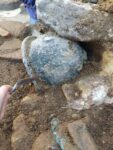 Archaeologists have discovered arms and armature used in a seminal 6th century B.C. battle at the ancient city of Velia in the Campagnia region of southwestern Italy. Two bronze helmets in perfect condition and numerous fragments of weapons including a shield were discovered on the Acropolis of Velia in the deepest archaeological layer dating to the city’s founding around 538–535 B.C.
Archaeologists have discovered arms and armature used in a seminal 6th century B.C. battle at the ancient city of Velia in the Campagnia region of southwestern Italy. Two bronze helmets in perfect condition and numerous fragments of weapons including a shield were discovered on the Acropolis of Velia in the deepest archaeological layer dating to the city’s founding around 538–535 B.C.
The city was founded by Greeks from Phocaea, the survivors of one of the first large-scale naval battles in history. The clash took place off the 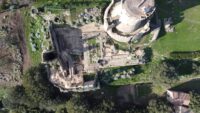 southern coast of Corsica in sometime between 541 and 535 B.C. The Phocaean Greeks had founded the city of Alalia (modern-day Aleria) in 566 B.C. and the Etruscans and Carthaginians objected to the Greek incursions into their Mediterranean territories. It came to watery blows in 540 B.C. when a fleet of 60 Greek ships faced off against 120 ships in the allied Etruscan and Punic fleet.
southern coast of Corsica in sometime between 541 and 535 B.C. The Phocaean Greeks had founded the city of Alalia (modern-day Aleria) in 566 B.C. and the Etruscans and Carthaginians objected to the Greek incursions into their Mediterranean territories. It came to watery blows in 540 B.C. when a fleet of 60 Greek ships faced off against 120 ships in the allied Etruscan and Punic fleet.
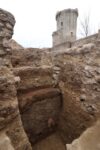 According to Herodotus the Greeks managed to eke out a victory of sorts, but it was Pyrrhic as they lost the vast majority of their ships and were forced to evacuate Corsica. The Etruscans took Corsica and Carthage maintained its hold on its Sardinian territories. The Phocaeans sought refuge in southern Italy, founding the city of Hyele, renamed Velia by the Romans.
According to Herodotus the Greeks managed to eke out a victory of sorts, but it was Pyrrhic as they lost the vast majority of their ships and were forced to evacuate Corsica. The Etruscans took Corsica and Carthage maintained its hold on its Sardinian territories. The Phocaeans sought refuge in southern Italy, founding the city of Hyele, renamed Velia by the Romans.
Excavations under the remains of the Temple of Athena on Velia’s Acropolis 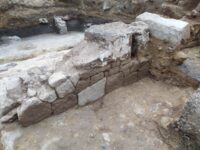 unearthed a rectangular structure 60 feet long and 23 wide with a beaten clay floor dating to the city’s founding between 540 and 530 B.C., predating the Temple of Athena by at least 50 years. Archaeologists found painted ceramics with the word “Ire” (“holy”) scratched into the surface, marking them as votive offerings left in the sacred space.
unearthed a rectangular structure 60 feet long and 23 wide with a beaten clay floor dating to the city’s founding between 540 and 530 B.C., predating the Temple of Athena by at least 50 years. Archaeologists found painted ceramics with the word “Ire” (“holy”) scratched into the surface, marking them as votive offerings left in the sacred space.
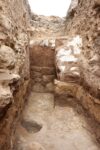 The bronze helmets were found in the same space. One is Etruscan of the Negau or shell type. The other is a Chalcidian type helmet.
The bronze helmets were found in the same space. One is Etruscan of the Negau or shell type. The other is a Chalcidian type helmet.
That is, in fact, the biggest surprise: “They are reliquaries offered to Athena, with all probability the very spoils from the Battle of Alalia,” says Osanna, who pending the installation of the new site director, Tiziana D’Angelo, has taken on the running of the Park over the last year.
These are, of course, only preliminary considerations. Freed from the earth only a few days ago, the two helmets must now be cleaned in the laboratory and studied. There may be inscriptions inside them, something quite common in ancient armour, and any inscriptions could help reconstruct with precision their history and, who knows, also perhaps the identity of the warriors who wore them. […]
It is almost certain that the foundation of the temple in this process was to be considered of crucial importance for the success of the new settlement and that the memory of the bloody battle was still very fresh, so much so that they decided to offer the goddess, in order to propitiate her benevolence, the weapons they had stripped from their Etruscan enemies in that epic clash on the sea which in fact changed the balance of power in the Mediterranean.
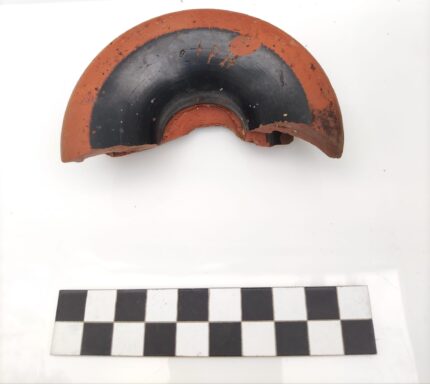
As those Phocaean Greeks came from Phocaea –in what today is Turkey– they were first in line against the invading Persians under Harpagos in the 6th century. Also, they seem to have had an extensive trade network.
Corsica was referred to by the Greeks as “Kyrnos” (Κύρνως). After the battle, they temporarily ended up in Rhegion (Ῥήγιον, modern Reggio di Calabria in Italy). From there, they made it to Velia/ Hyele/ Ὑέλη, according to Herodotus.
Caere (the Latin name of Cerveteri 50-60 kilometres north-northwest of Rome) was known to the Greeks as “Agylla” (Ἄγυλλα). Apparently, some of the survivors of the battle were executed there. The spot of execution became “haunted”, which the Etruscans evidently solved by helding sports events.
:hattip:
———-
1.164: “…the Phocaians, being very greatly grieved at the thought of subjection, said that they wished to deliberate about the matter for one day and after that they would give their answer; and they asked him to withdraw his army from the wall while they were deliberating. Harpagos said that he knew very well what they were meaning to do, nevertheless he was willing to allow them to deliberate. So in the time that followed, when Harpagos had withdrawn his army from the wall, the Phocaians drew down their fifty-oared galleys to the sea, put into them their children and women and all their movable goods, and besides them the images out of the temples and the other votive offerings except such as were made of bronze or stone or consisted of paintings, all the rest, I say, they put into the ships, and having embarked themselves they sailed towards Chios; and the Persians obtained possession of Phocaia, the city being deserted of the inhabitants.
1.165. But as for the Phocaians, since the men of Chios would not sell them at their request the islands called Oinussai, from the fear lest these islands might be made a seat of trade and their island might be shut out, therefore they set out for Kyrnos: for in Kyrnos twenty years before this they had established a city named Alalia, in accordance with an oracle, (now Arganthonios by that time was dead). And when they were setting out for Kyrnos they first sailed to Phocaia and slaughtered the Persian garrison, to whose charge Harpagos had delivered the city; then after they had achieved this they made solemn imprecations on any one of them who should be left behind from their voyage, and moreover they sank a mass of iron in the sea and swore that not until that mass should appear again on the surface would they return to Phocaia. However as they were setting forth to Kyrnos, more than half of the citizens were seized with yearning and regret for their city and for their native land, and they proved false to their oath and sailed back to Phocaia. But those of them who kept the oath still, weighed anchor from the islands of Oinussai and sailed.
166. When these came to Kyrnos, for five years they dwelt together with those who had come thither before, and they founded temples there. Then, since they plundered the property of all their neighbours, the Tyrsenians and Carthaginians made expedition against them by agreement with one another, each with sixty ships. And the Phocaians also manned their vessels, sixty in number, and came to meet the enemy in that which is called the Sardinian sea: and when they encountered one another in the sea-fight the Phocaians won a kind of Cadmean victory, for forty of their ships were destroyed and the remaining twenty were disabled, having had their prows bent aside. So they sailed in to Alalia and took up their children and their women and their other possessions as much as their ships proved capable of carrying, and then they left Kyrnos behind them and sailed to Rhegion.
167. But as for the crews of the ships that were destroyed, the Carthaginians and Tyrsenians obtained much the greater number of them, and these they brought to land and killed by stoning. After this the men of Agylla found that everything which passed by the spot where the Phocaians were laid after being stoned, became either distorted, or crippled, or paralysed, both small cattle and beasts of burden and human creatures: so the men of Agylla sent to Delphi desiring to purge themselves of the offence; and the Pythian prophetess bade them do that which the men of Agylla still continue to perform, that is to say, they make great sacrifices in honour of the dead, and hold at the place a contest of athletics and horse-racing. These then of the Phocaians had the fate which I have said; but those of them who took refuge at Rhegion started from thence and took possession of that city in the land of Oinotria which now is called Hyele. This they founded having learnt from a man of Poseidonia that the Pythian prophetess by her answer meant them to found a temple to Kyrnos, who was a hero, and not to found a settlement in the island of Kyrnos.
———-